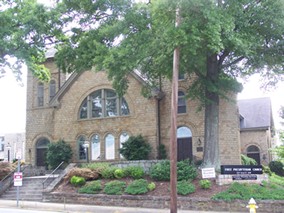First Presbyterian Church
Introduction
Text-to-speech Audio
Images
Front view of the church

Backstory and Context
Text-to-speech Audio
In 1873, three years after the town of Hickory was incorporated, a small mission of 15 members called Gibbs' Mission was founded and named after Reverend G. M. Gibbs, who ministered at multiple churches in the area. Having no church of their own, the mission met in a local Methodist church until 1878, when the Gibbs' Mission group constructed their first church, which was called Hickory Presbyterian Church. The congregation continued to grow under the guidance of reverends Thomas Thurston, who ministered from 1879-1884, and Colin Monroe, who ministered from 1885-1891. By 1891, the church was able to afford a full-time pastor, and Reverend James Alston Ramsey, D. D., was hired. In the same year, the first manse was constructed and the Woman's Missionary Society was formed.
When Dr. Ramsay passed away from pneumonia on January 11th, 1900, Reverend W. T. Matthews became the minister for the church, a position he would hold until 1903. During his time at the church, Matthews purchased a lot that would be used in the construction of a new sanctuary farther away from the train tracks. Reverend C. W. Trawick took over for Matthews and oversaw the completion of the current sanctuary, which was dedicated on December 2nd, 1906. The Bowman Brothers architectural firm located in Knoxville, Tennessee, drew the plans for the new building. When Trawick's stint at the church ended in 1907, John G. Garth's pastorate began, which lasted until 1918. It was under Garth that original manse was sold and a new manse was constructed and a pipe organ was purchased.
The longest pastorate of the church's history was that of Reverend John Richard Hays, D.D., who led the church from 1927-1952. Hays oversaw the construction of a three-story educational building in 1928 and the complete remodel of the church in 1949. Even after Hays' time with the church, the church continued to grow; a second educational building was constructed in 1957, and, in 1958, the church was one of five churches chosen by the Presbyterian United States Board of Christian Education to take part in a three year "Covenant Church Life" curriculum, which became the official educational curriculum of the Presbyterian faith from 1963-1978. Additionally, a new manse was purchased in 1962, and the sanctuary was air conditioned in 1967. The First Presbyterian Church is notable for remaining close to the downtown area, as other churches have moved closer to the edge of town, and for paralleling the growth and development of Hickory, NC, from a small tavern town to the strong industrial force of the twentieth-century. Today, the First Presbyterian Church still serves as a place of worship.
On March 15th, 1985, the First Presbyterian Church was added to the National Register of Historic Places for reflecting the growth of religious practices and development of religious spaces in Hickory, NC, and for being a well-preserved example of a Romanesque Revival-style church in the local area, as the exterior is relatively unchanged from initial construction. Two of the most striking features of the church are the gable roof with boxed and molded cornice and overhanging modillioned eaves and the Belgian block veneer.
Sources
Death of J. Alston Ramsay, Newspapers. Accessed October 22nd 2019. https://www.newspapers.com/clip/8233399/death_of_j_alston_ramsay/.
Jackson, Byron Haden. The Covenant Life Curriculum within its Historical Setting, Pocket Knowledge. October 18th 2006. Accessed October 23rd 2019. https://pk.tc.columbia.edu/item/The-Covenant-Life-Curriculum-Within-Its-Historical-Setting-14284.
Phillips, Laura A. W.. First Presbyterian Church, National Register of Historic Places. March 15th 1985. Accessed October 23rd 2019. https://files.nc.gov/ncdcr/nr/CT0178.pdf.
http://ncphsociety.org/newsletterSummer2013.html
